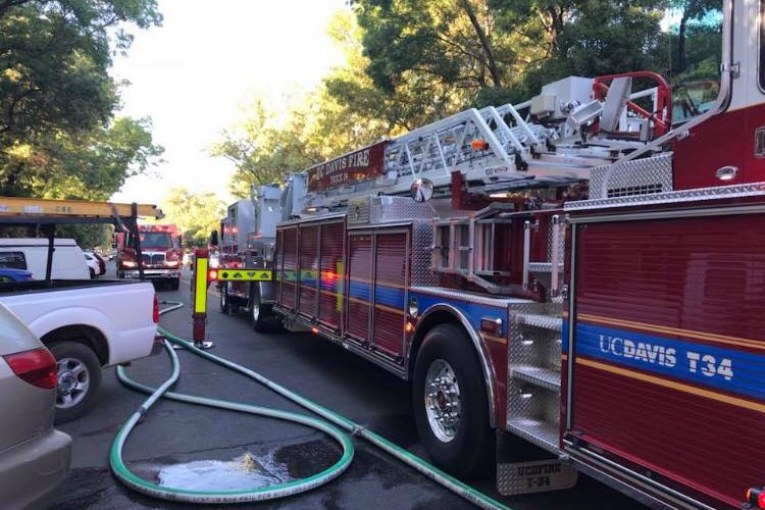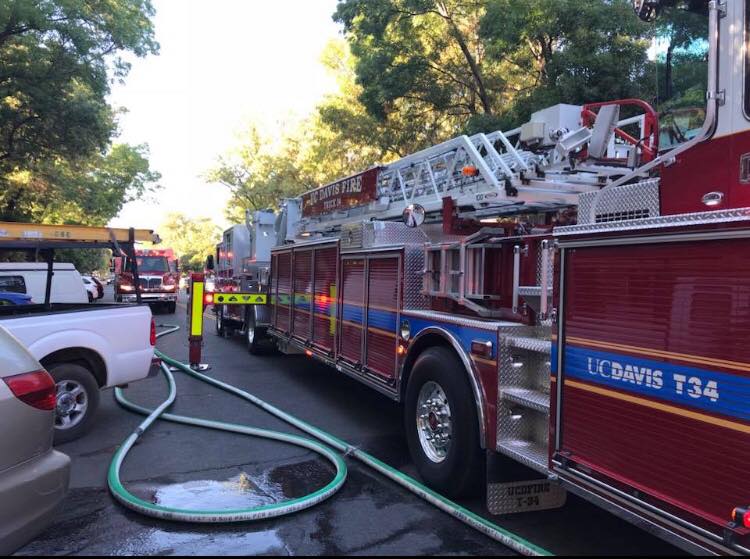

By David M. Greenwald
When the issue of the ladder truck first came forward, I thought I would end up supporting the proposal. After all, the city is increasingly densifying and building more and more buildings that are three, four or even more stories. The idea that the city should need to rely on UC Davis to fight those fires into the future does not make sense.
The one-time price tag, while steep, did not seem to be a good reason to oppose the purchase. After all, it is a one-time purchase and a one-time cost of revamping a fire station. The problem that stopped my support, however, was the ongoing staffing costs. The need to staff an additional three to six firefighters.
The city often doesn’t act like it anymore, but the city continues to teeter on the edge of fiscal sustainability. And as I have expressed here many times, my concern is how the city is going to finance basic city services into the future.
So isn’t public safety a basic city service? Absolutely. 
My question, however, is one of cost versus need.
The city will cite the Fitch and Associates Standards of Cover report.
In the Fitch and Associates Standards of Cover report, they found “it is recommended that the City of Davis invest in their own ladder truck.” It further said “that doing so would improve coverage, redundancy, critical tasks for structure fires and technical rescues. The report determined the best location would be Station 31.”
Lastly, the report said, “A community the size of the city of Davis with the complexity of risk should not be without consistent ladder truck service or depend on an apparatus from distant communities when the UC Davis apparatus is unavailable.”
But the city to me did not ask or answer some very basic questions. I pointed this out with my column from November:
As a subcommittee of Doug Buzbee, Ezra Beeman and Donna Neville pointed out: “The City cannot make this decision on the benefits of a new ladder truck without considering alternative ways of meeting this need. We need to know how many times the City has needed to make use of the UCD ladder truck over the past few years.”
They point out: “My understanding is that UCD has a ladder truck which is staffed with 4 fire fighters. According to the Davis Vanguard, this truck can reach anywhere in Davis within 8 minutes. Nothing in the staff analysis indicates whether a joint use agreement has been considered and we believe this should be explored.”
Then there is the subcommittee of Gurkern Sufi and Paul Jacobs, which concluded, “We both recognize the great service provided by our local firefighters and do not take this for granted.
“And we recognize that in this time of state-wide fire emergencies the DFD is often ‘stretched thin.’ We also appreciate the effort to secure grants wherever possible to improve service and reduce risk in our community.”
But they write, “[W]e also believe that every new commitment of City funds should be thoroughly reviewed before being adopted. And we recognize that, in the end, it is up to the Council to set priorities for how taxpayer dollars are expended. In that spirit, we offer these questions and comments.”
They ask seven critical questions:
- How many 3-story vs. 4-story buildings does Davis now have? (The November report to council says more than 200. It notes, for example, there have been a number of fires at the University Retirement Community, which includes 4-story structures.)
- How frequent are fires at these two building heights respectively?
- How are these fires contained without a ladder truck?
- How many 5-7 story buildings are there in the City currently? How many are in construction? How many are in the planning phases?
- How often have ladder trucks from UC Davis and other jurisdictions been called on?
- How often has the UC Davis ladder truck been used for on-campus fires?
- What is the probability that the UC Davis truck would not be available should there be a fire in a multi-story building in the City? Has this ever happened?
In my view, the problem with the Fitch and Associates report is that they looked at the general description of Davis—size of the community and structure of the buildings—and decided that a community the size of Davis needs a ladder truck.
But what they failed to present were three considerations: (1) Davis is unique because it has a university next door with an available ladder truck; (2) how many times we actually need the ladder truck to respond to a call; and (3) the fiscal situation of the city and huge hit that an ongoing cost of $645 thousand to $1.26 million would produce.
This is a community that is struggling to pave its roads. If we need a ladder truck a few dozen times a year, is it worth that extra cost? Especially when we have a solution in place that is working at the present time?
To reframe the question—is this a need to have or a nice to have? Here we must weigh the costs of staffing the acquisition against the need we have for a truck, when we have alternatives that currently serve our needs.
It seems to be that this needed to be part of a broader community discussion much earlier than it was. The need for a ladder truck with adding fire personnel has never been part of a discussion about infill and densification. That means that the community never had a chance to weigh in on the full future costs going up. In a community where our finances are as tight as they are, and where we already face a real deficit near $10 million, that seems to have been a glaring omission.
The city council will probably move forward with this, and they will probably put a Utility User Tax on the next ballot to finance it—the problem is that the voters will likely not be fully apprised of the true costs and tradeoffs of spending the money on this versus other clear needs.
—David M. Greenwald reporting
Support our work – to become a sustaining at $5 – $10- $25 per month hit the link:







Which you support.
Why does it not make sense? It makes total sense.
Yes it does. IF it is not needed.
Uh huh.
If it is needed and needs staff, both are needed. If it is not needed, it isn’t needed nor is the staff. These are not separate.
Whom you oppose.
I agree with your conclusion, but not your logic in getting there.
I fully affirm Alan M’s points… but would add that, David’s assertion,
I assert, it would be more accurate to say, “if we even needed a ladder truck ONCE every dozen years”… really changes the cost/benefit analysis, as well…
After nearly 50 years in this community, only time I’ve seen the ladder truck on City streets has been in a Picnic Day parade… not sure if there was even one deployed for the Drake Apartment fire…
As I understand it, you generally fight fires at the base, not the top…
“As I understand it, you generally fight fires at the base, not the top…”
First you vent them from the top to prevent the fire from flashing over then you fight them at the base.
While you were writing about defunding the police the firefighters were working on winning the City Council election. And they did, so, here we are. They may try a utility tax but I’m not sure that is needed for this. The City will use stimulus money to purchase the truck and property tax money from U Mall, Sterling, Davis Live and, whatever other projects come forward, to fund the ongoing increase in staff. Meanwhile the elementary kids will be biking over crumbling streets like at Pine and Cornell as Davis’ unsafe bike to school program continues to be underfunded as the old pre-prop 13 infrastructure continues to crumble. The City budget will remain perennially underfunded. Its the same as it ever was.
Untrue… GF money is GF money… ‘source’ is irrelevant…
True. To a certain extent… I do tire of the “it’s for the kids” mantra, ‘tho… and yes, we get the Pine and Cornell thingy… a personal issue for you, apparently…
“End of Day”, Davis does not need a ladder truck, and all the initial, and on-going, costs associated therewith… I can think of at least a dozen items/programs that could use that $$$…
“True. To a certain extent… I do tire of the “it’s for the kids” mantra, ‘tho… and yes, we get the Pine and Cornell thingy… a personal issue for you, apparently…”
In this case that corner is heavily used by kids going to and from school. The street is falling apart at some of the corners and breaking up into fist sized chunks of street aggregate. Kids as young as five are going to be biking across there as soon as schools reopen in a few weeks.
Its not a personal thing for me. It is emblematic of the neglect of basic infrastructure in this town.
“GF money is GF money… ‘source’ is irrelevant…”
Yes General Fund money is fungible. But what a convenient coincidence that this massive new budget item comes up right after the Biden Stimulus Bill got signed.
This is happening with everything, everywhere. A wise and left-leaning friend once told me, ‘the worst thing you can do for a government program is give them a big pot of money’. It took me awhile to understand what he meant. Now many Dem faves (often follow the union benefit) have a big pot of money.